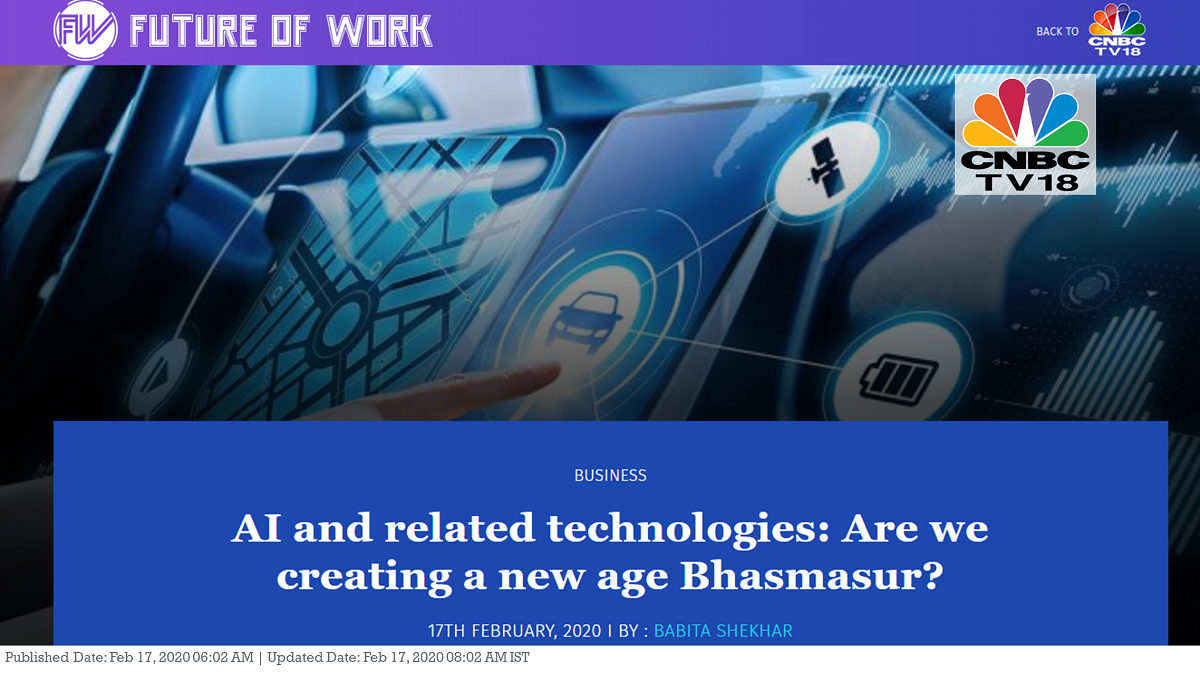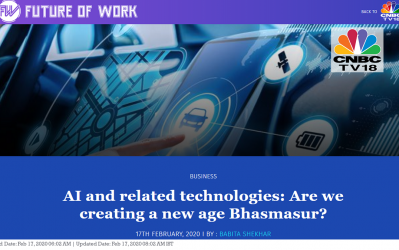
“We see debates about humans vs. machines and questions about when machines will become more intelligent than human beings, speculation over whether they’ll keep us around as pets or just conclude we were actually a bad idea and eliminate us”
— Joichi Ito, EI
Many of us may remember the story of Bhasmasur. For those who haven’t a clue what I am talking about, the story (as I remember it) goes that one of the ambitious ‘Asurs’ did severe penance to win the blessings of Lord Shiva. Pleased with his devotion, Lord Shiva appeared and blessed him with a boon. The Asur asked for a boon wherein he could reduce to ashes any of his enemies by simply placing his hand over their head. Shiva said tathastu (so be it) and so began a reign of terror by Bhasmasur. Beseeched by pleas for help by the rishis, Vishnu appeared in the alluring form of Mohini. Bhasmasur was smitten by the beauty and asked her to marry him. Mohini laid the condition that he should follow her every move in dance, to win her hand. So, the two danced, matching step for step, and in the process, Mohini placed her hand over her head and the ‘Asur’ following her, was reduced to ashes. You may wonder what this ancient story has to do with modern-day inventions like AI and ML? Does it have any significant lessons for man in his quest for the next technological breakthrough?
Artificial Intelligence (AI), Machine Learning (ML) and the rise of the robots have generated awe, excitement and fear. Scientists from all fields are deep into creating an intelligence that might rival, if not supersede, human intelligence. The continuum from automation to extended intelligence, promises to disrupt human endeavour as we have not seen since the industrial revolution, wherein a work culture developed which made humans a mere cog in the wheels of the machines. The sweatshops lasted for some time before policies and social practices were devised to restore human dignity once again.
Revisiting the fears of Industrial Revolution
AI and related technologies are promising to create the next tectonic shift in the way we treat work and more importantly the workers. Debates are already raging over the future of work. Will automation and robots replace human endeavour? Economists, scientists and policymakers are envisioning a future where machines will replace humans to the point where they would have to subsist on a universal basic income (UBI).
It appears that we are revisiting the fears of the Industrial Revolution, which made dire predictions about the march of machines. Wassily Leontief, the winner of the 1973 Nobel Prize in Economics, noted in 1952, “Labour will become less and less important. . . More workers will be replaced by machines. I do not see that new industries can employ everybody who wants a job”. However, despite these oft-recurring concerns, society continues to undergo profound transformations, the economy continues to grow, technology continues to advance, and workers continue to have jobs. Given this history of concern, what makes human labour resilient to automation? Is AI a fundamentally new concern from the technologies of the past? Time has proved that humans have been able to repeatedly move past their own inventions to the next level of displacement.
There is no gainsaying the fact that automation and artificial intelligence can contribute significantly to value creation. All evidence points to the new technology leading to vast gains in productivity, and hence to economic growth. A study conducted by McKinsey Global Institute of hundreds of AI use cases found that the most advanced deep learning techniques using artificial neural networks could account for nearly $3.5-5.8 trillion in annual value, which approximates 40 percent of the value created by all analytics techniques, though the range and impact vary with industries and sectors.
That is not to say that there will not be any loss of work. Predictable, routine, manual tasks will be the first to be automated, and in fact we see evidence of this already. A ubiquitous example being the ATM, which has replaced the erstwhile bank teller. However, the bank teller job is not entirely lost, but rather has undergone a transformation of its own, taking on a more complex role of client / customer management rather than simply dispensing cash.
The World Bank’s 2016 World Development Report noted a global trend towards “hollowing out” of the labour force. As technology streamlines routine tasks, middle-skill jobs like clerical workers and machine operators decline while both high-skill and low-skill ones increase. We may also be giving less credence to the labour-intensive services sector to create employment, a sector that is growing rapidly in countries like India.
It is postulated by many that AI and related technologies have the capacity to make the world a better place by helping to eliminate world-wide poverty, manage and control effects of climate change and resulting migration, reduce diseases and provide education to all, to name a few. However, the flip side also raises the spectre of deepening economic inequalities, leaving the already marginalised even further behind; increasing concentration of wealth and power; and creating even more horrifying weapons of war. So, which path will we take? Erik Brynjolfsson, director of the MIT Initiative on the Digital Economy and author of Machine, Platform, Crowd: Harnessing Our Digital Future has aptly pointed out that “the right question is not ‘What will happen?’ but ‘What will we choose to do?’” Neither side of the argument will play out in entirety or exclusively. What we will probably see is an interplay of outcomes, and it should be our endeavour to magnify the positives and reduce the negative fallouts.
Intelligent use of super-human technologies
It is imperative that to enhance the positive outcomes of AI, ML and related technologies, we develop the human capital which has the capability to make intelligent and wise use of such super-human technologies. This points to a need for overhauling the current education system based on rote learning and unquestioning acceptance of thoughts and theories expounded by masters in the pre and post-industrial era. The need of the times is to create minds capable of thinking creatively to stay ahead of the capacities of modern computers and robots. Employment will largely be available to out-of-the-box thinkers and such human resources can only be created by an education system which lays stress on innovative teaching models and flexible courses / syllabi. As rightly said by Alvin Toffler “The illiterate of the 21st century will not be those who cannot read and write, but those who cannot learn, unlearn, and relearn.”
With rapid technological turnover, the skill requirements of each job title will not remain static but evolve over time. We won’t need to prepare our workforce just once, with a few changes to the curriculum. As AI matures, we will need a responsive workforce, capable of adapting to new processes, systems and tools every few years. It is important to create a platform and capacity to learn, unlearn and re-learn at short notice to ensure relevance and employability. Moreover, the new education system must be designed with the capacity to create new hybrid-skilled knowledge workers who can operate in jobs that have never needed to exist before.
Many educational institutions are already experimenting with new teaching models and systems focused on human capacity enhancement. The current model of fixed curriculums which are upgraded at random intervals may be a thing of the past. Institutions and universities may have to create a bank of courses that provide the basic knowledge, with a wide range of courses / electives that allow students to acquire knowledge and skills in emerging fields, which makes them employable. A closer association with industry may become imperative. On the other hand, for a country to achieve competitive advantage in ‘literate’ labour force, a strong research base would be equally indispensable. Innovation should not be restricted merely to technology, but innovation in child psychology, learning theories and teaching methods4 would enhance the skills and capability development. To foster creativity and interest, education should focus on the inherent abilities and interests of the students and create systems to enhance these abilities.
Humans are in a race for creating superintelligence, but they may also inadvertently be getting into a race to their own annihilation, unless they acquire the flexibility and dexterity to dance their way out of the trouble of their own making, a la Mohini vis a vis Bhasmasur.
——-<><><>——–
Author: Babita Shekhar is an Advisory Board Member of iE3 Innovations Pvt. Limited, a technology firm.
Published in:


